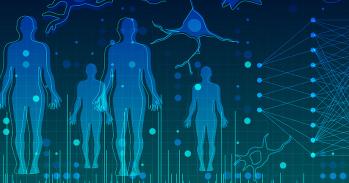New research shows that the whip-like appendages on many types of cells are able to synchronise their movements solely through interactions with the fluid that surrounds them.
New research shows that the whip-like appendages on many types of cells are able to synchronise their movements solely through interactions with the fluid that surrounds them.
The search for the mechanisms underlying synchronisation can yield insights on many fronts
Raymond Goldstein
Many different types of cell, including sperm, bacteria and algae, propel themselves using whip-like appendages known as flagella. These protrusions, about one-hundredth of a millimetre long, function like tiny oars, helping cells move through fluid. Similar, shorter structures called cilia are found on the surfaces of many cells, where they perform roles such as moving liquids over the cell.
Flagella and cilia are remarkably versatile: they transport mucus and expel pathogens from our airways, they establish the left-right asymmetry in developing vertebrate embryos, and transport human eggs through the Fallopian tube. Each cilium or flagellum beats to its own characteristic rhythm, but wherever large groups of these biological paddles are found, they tend to row in sync, as though led by a cox.
Exactly what causes these microscopic rowers to move together is something of a mystery. Experiments in the 1940s demonstrated that the flagella of bull sperm tend to synchronise when they swim close to one another, connected only through the fluid surrounding them. However, the precise mechanism through which groups of cilia and flagella lock into sync with one another is not entirely clear.
A long-standing hypothesis is that movement of the fluid due to the beating flagella could be the reason they move in unison. While previous experimental findings were consistent with mathematical theories describing the fluid motion, these experiments could not exclude other mechanisms for achieving synchronisation, such as chemical signalling or physical connections between flagella.
Now, using a newly devised experimental procedure, researchers from the University of Cambridge have been able to disentangle the various mechanisms, and show that the fluid motion created by two beating flagella is sufficient by itself to cause them to row in sync. The findings are published today (29 July) in the journal eLife.
The team, based in the Department of Applied Mathematics and Theoretical Physics, included Dr Douglas Brumley (now at MIT), PhD student Kirsty Wan, Dr Marco Polin (now at the University of Warwick), and Professor Raymond E. Goldstein.
The group used high-speed imaging and microscopy to observe the flagella of two physically separated cells of a species of green alga called Volvox carteri. Holding the cells on micromanipulators of the kind used in in vitro fertilisation, they were able to vary systematically the spacing between the cells in the fluid. At wide separations, the two flagella beat at different rates, with rhythms governed by their distinct intrinsic frequencies.
However, the team found that when brought close enough together, the two flagella could lock together into the same rhythm for thousands of beats at a time. In a striking compromise between their natural frequencies, the two flagella each produce flows that are sufficient for the pair to synchronise their motions.
Additionally, by analysing the time series of beating, the team could determine the strength of the interaction between the flagella, which was found to agree with basic fluid dynamical calculations.
“This research was the culmination of many years of work in this area, and we are very excited to see how a quantitative approach to a problem in biology can answer fundamental questions,” said Dr Polin.
In separate work led by Drs Brumley and Polin, the group has been investigating the dynamics of thousands of interacting Volvox flagella that produce coherent patterns like Mexican waves in a stadium, which are also apparently driven by hydrodynamic interactions between the filaments.
At the same time, Wan has been investigating the noisy beating of algal flagella, and has discovered that they exhibit beat-to-beat fluctuations that are qualitatively similar to the fluctuations in human heart beats. “Taken together,” says Goldstein, “these results indicate the remarkable way in which green algae can serve as model organisms for fluid dynamical problems that relate to human health and disease. In this particular case, the coordination of flagella plays vital roles in phenomena ranging from embryo development to respiratory physiology, and thus the search for the mechanisms underlying synchronisation can yield insights on many fronts.”
This work was supported by the European Research Council, the EPSRC, and the Wellcome Trust.
The text in this work is licensed under a Creative Commons Licence. If you use this content on your site please link back to this page. For image rights, please see the credits associated with each individual image.





